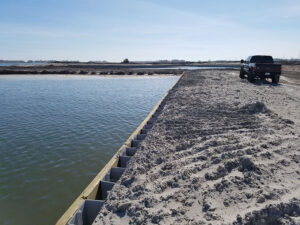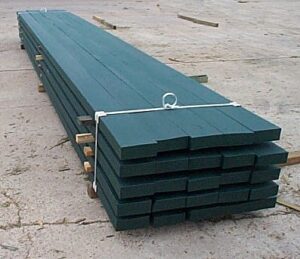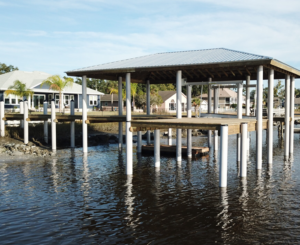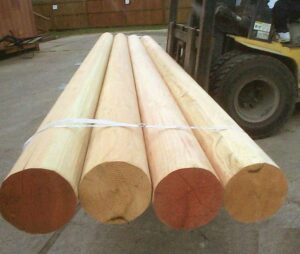The Ultimate Guide to Choosing the Right Piling Material for Your Marine Project
When it comes to marine piling and shoreline construction, selecting the right piling material is crucial for long-term durability, cost-effectiveness, and structural integrity. Whether you are building a dock, pier, bulkhead, or foundation, understanding the pros and cons of different materials can help you make an informed decision.
In this guide, we’ll explore various piling materials—including vinyl, timber, concrete, and steel—and highlight why gun barrel pilings and treated timber pilings are excellent choices for many marine applications. We’ll also discuss key factors such as soil conditions, water type, load requirements, and environmental impact to ensure your project’s success.
Understanding Marine Piling Materials

1. Vinyl Piling
Vinyl piling is often used for bulkheads and seawalls, providing a sleek and modern alternative to traditional materials.
✅ Pros:
- Highly resistant to rot and corrosion
- Low maintenance
- Lightweight and easy to install
- Excellent for saltwater environments
❌ Cons:
- Not as strong as other materials for load-bearing applications
- Can be more expensive upfront
- Limited size and structural versatility

2. Treated Timber Piling
Treated timber piling remains a popular choice for docks, piers, and foundation supports due to its natural durability and aesthetic appeal.
✅ Pros:
- Cost-effective compared to steel and concrete
- Environmentally friendly when sustainably sourced
- Naturally flexible, reducing breakage under heavy loads
- Excellent for freshwater applications
❌ Cons:
- Vulnerable to marine borers and termites in saltwater environments
- Requires regular maintenance and treatment
- Shorter lifespan compared to steel or concrete
3. Gun Barrel Pilings: The Superior Timber Option
Gun barrel pilings are a specialized form of treated timber piling, designed for superior strength and longevity.
✅ Key Advantages:
- Solid uniformity with no taper, providing better load distribution
- Pressure-treated for superior resistance to rot, decay, and marine borers
- More durable than standard treated wood pilings
- Ideal for both residential and commercial applications
4. Concrete Piling
Concrete piling is commonly used in commercial marine projects and large-scale infrastructure.
✅ Pros:
- Extremely durable with a lifespan of over 50 years
- Resistant to marine borers, rot, and corrosion
- Ideal for heavy-load applications
❌ Cons:
- Expensive installation and transportation costs
- Prone to cracking under extreme conditions
- Requires reinforced steel, which can corrode over time
5. Steel Piling
Steel piling is often used for deep foundations and high-load applications in industrial marine projects.
✅ Pros:
- Exceptional strength and load-bearing capacity
- Durable in both saltwater and freshwater
- Long lifespan with proper coatings and maintenance
❌ Cons:
- Highly susceptible to rust and corrosion
- Expensive and labor-intensive to install
- Requires protective coatings for longevity
Key Factors to Consider When Choosing Piling Material
1. Water Type: Saltwater vs. Freshwater
- Saltwater environments require materials resistant to corrosion and marine borers (vinyl, concrete, or treated gun barrel pilings are excellent options).
- Freshwater projects can benefit from treated timber pilings, as they provide durability without excessive deterioration.
2. Soil Conditions
- Sandy or loose soils: Best suited for steel, concrete, or treated timber pilings.
- Rocky or hard soils: Require steel or concrete for deep penetration.
- Soft mud or clay: Gun barrel pilings or steel pilings provide the necessary structural integrity.
3. Load Requirements
- Light structures (docks, small piers): Treated timber or vinyl pilings work well.
- Medium loads (residential bulkheads, marinas): Gun barrel pilings, concrete, or vinyl are good choices.
- Heavy industrial loads (bridges, commercial piers): Concrete or steel pilings are the best options.
4. Environmental Impact
- Sustainable wood sources: Treated timber and gun barrel pilings are environmentally friendly options when sourced responsibly.
- Recyclable materials: Steel and concrete offer longevity and recyclability.
- Eco-conscious alternatives: Vinyl piling minimizes the need for preservatives and reduces long-term waste.
Why Choose Gun Barrel Pilings and Treated Timber for Your Project?
At Building Products Plus, we specialize in high-quality gun barrel pilings and treated timber pilings, offering superior strength, longevity, and cost-effectiveness for your marine piling and shoreline construction projects.
Our gun barrel pilings provide:
- Uniform diameter for enhanced structural stability
- Pressure-treated protection against marine borers and decay
- A cost-effective alternative to steel and concrete
Our treated timber pilings are:
- Ideal for docks, piers, and foundation supports
- Sustainably sourced and environmentally responsible
- Affordable and easy to install

Conclusion
Selecting the right marine piling material is essential for ensuring the longevity and stability of your shoreline construction project. Whether you opt for vinyl bulkhead, treated timber piling, gun barrel piling, steel, or concrete, understanding your project’s requirements will help you make the best choice.
For expert advice and high-quality piling materials, contact Building Products Plus today! 📞 (800) 816-0335
🔗 Visit our website

